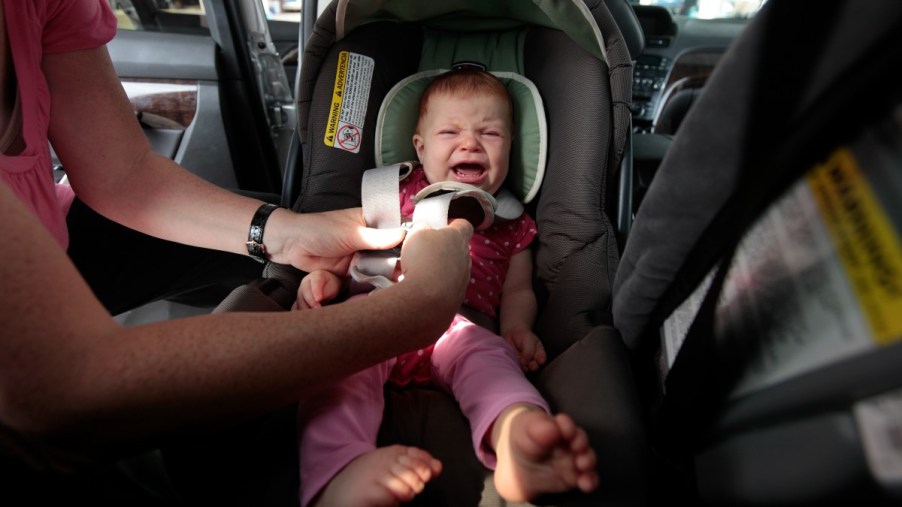
Over Half of Child Car Seats Have Toxic Chemicals, Says Study
Child car seats play a crucial role in reducing the number of injuries of deaths of children in car accidents. However, many child car seats have unintended negative consequences. According to a recent study, over half of child car seats have toxic chemicals.
More than half of child car seats have toxic flame retardants and PFAS

The Ecology Center, an environmental and consumer advocacy group, recently conducted a study on child car seats, as reported by The Guardian. The study inspected “more than 600 components on 25 seats manufactured by popular brands in the US and EU.” This includes Baby Trend, Graco, and Evenflo. It found that over half of child car seats tested for toxic flame retardants and PFAS (per-and polyfluoroalkyl substances) contain these dangerous chemicals.
Also, The Ecology Center found that all child car seats that cost less than $100 contain either flame retardants or PFAS. As a result, lower-income children are more likely to be exposed to these toxic substances.
In its report, The Ecology Center said that “there is no evidence the nation’s flammability standards have prevented car seat deaths over the last 50 years.” It added, “Many car seat companies are creating a hazardous exposure problem to follow a broken regulation.”
What are the potentially harmful effects of toxic chemicals in child car seats?

The potentially harmful effects of “phosphorus- and bromine-containing flame retardants” in child car seats include:
- Cancer
- Developmental disorders
- Diabetes
- Endocrine disruption
- Other serious health issues
Some child car seats have PFAS for their “water-, stain- and grease-resistant” properties. Potentially adverse health effects of PFAS include:
- Cancer
- Liver problems
- High cholesterol
- Decreased immunity
- Thyroid disease
- Other serious health issues
Flame retardants and PFAS “can be breathed in or ingested as they break off from the materials” from which they are applied. Also, these toxic chemicals can be absorbed by the skin. Furthermore, PFAS are harmful to the environment. They are called “forever chemicals,” due to their longevity in ecosystems.
For the study, “55% of the 22 US seats contained phosphorus-based flame retardant in the upholstery.” Also, “nine contained bromine in the upholstery or foam.” Additionally, “four seats marketed as water- and stain-resistant contained PFAS.”
Notably, “car seats purchased in the EU did not contain phosphorus-based flame retardants, even when the same product sold in the US did.” Some of the “EU seats contained bromine,” though. However, bromine is less of a concern because it is typically “covered by upholstery.”
Are there alternatives to toxic chemicals in child car seats?
Alternatives to toxic flame retardants in child car seats include “wool or dense, tightly woven polyester fabric,” according to Melissa Cooper Sargent, The Ecology Center’s green living resources director. However, it’s “difficult for manufacturers to build and sell flame retardant-free seats for under $100.” This is “because the chemicals are cheaper than thick polyester fabrics.” Cooper Sargent added, “Companies are saying, ‘That’s as low as we can go.’”
Outdated flammability regulations are also to blame for the harmful child car seat chemicals
Due to the difficulty in making toxic-free child car seats that are inexpensive, The Ecology Center has “turned its attention” to regulations that it views as unnecessary and outdated.
Cooper Sargent said, “US flammability rules trace back to cigarette manufacturers that wanted the chemicals used in furniture and car seats to prevent fires started by people dropping cigarettes.” However, the overwhelming majority of car fires “start in the engine block.” Therefore, “flame retardants are largely ineffective.” Furthermore, the toxic chemicals in child car seats “create a health hazard for firefighters who may inhale the smoke.”
Also, “the EU recently changed its 50-year-old flame retardant standard” for child car seats.” This standard was based on US rules. Following the EU regulation change, The Ecology Center hopes the US will follow the same path. With a proposal, it is “pressuring legislators and the US Department of Transportation secretary, Pete Buttigieg.” Cooper Sargent added that the “proposal has the support of 40 environmental and consumer advocacy groups.” The Juvenile Manufacturers Trade Association supports the proposal as well.
One of the major points of the proposal is that the “current rules unfairly expose lower-income kids.” In the proposal, The Ecology Center wrote, “Affordable car seats should come without chemical costs to kids.”


